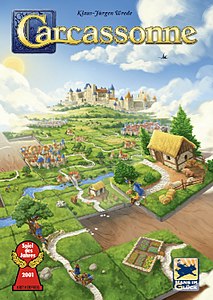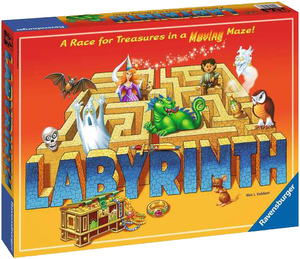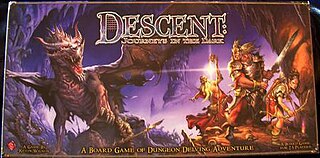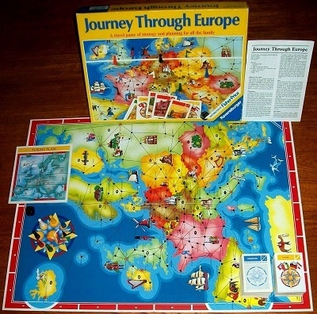
Java is a German-style board game designed by Wolfgang Kramer and Michael Kiesling and published in 2000 by Ravensburger in German and by Rio Grande Games in English. It is illustrated by Franz Vohwinkel.

Scotland Yard is a board game in which a team of players controlling different detectives cooperate to track down a player controlling a criminal as they move around a board representing the streets of London. It was first published in 1983. It is named after Scotland Yard - the headquarters of London's Metropolitan Police Service in real-life. Scotland Yard is an asymmetric board game, during which the detective players cooperatively solve a variant of the pursuit-evasion problem. The game is published by Ravensburger in most of Europe and Canada and by Milton Bradley in the United States. It received the Spiel des Jahres award in 1983 - the same year that it was published.

Carcassonne is a tile-based German-style board game for two to five players, designed by Klaus-Jürgen Wrede and published in 2000 by Hans im Glück in German and by Rio Grande Games and Z-Man Games (currently) in English. It received the Spiel des Jahres and the Deutscher Spiele Preis awards in 2001.

Reiner Knizia is a prolific German-style board game designer.

Mexica is a board game designed by Wolfgang Kramer and Michael Kiesling and published in 2002 by Ravensburger in German and Rio Grande Games in English. Mexica was awarded 5th prize in the 2002 Deutscher Spiele Preis.

Top Secret Spies is a spy-themed German-style board game designed by Wolfgang Kramer and published in 1984 by Ravensburger. The game, also known as Under Cover or Detective & Co, won the Spiel des Jahres award in 1986.

Ticket to Ride is a railway-themed German-style board game designed by Alan R. Moon. It was illustrated by Julien Delval and Cyrille Daujean and published in 2004 by Days of Wonder. The game is also known as Zug um Zug (German), Les Aventuriers du Rail (French), Aventureros al Tren (Spanish), Wsiąść do pociągu (Polish), and Menolippu (Finnish).

Mensch ärgere Dich nicht is a German board game, developed by Josef Friedrich Schmidt in 1907/1908. Some 70 million copies have been sold since its introduction in 1914 and it is played in many European countries.

Labyrinth is a board game for two to four players, published by Ravensburger in 1986.

Hare and Tortoise is a German-style board game designed by David Parlett in 1974 and first published by Intellect Games. In 1978 it was released by Ravensburger in Germany, where the game became a huge hit. It has since sold some 2 million units in at least ten languages, including several known pirated editions. The current edition is published by Gibsons Games in the UK, Ravensburger in Germany and Rio Grande Games in the United States.

Alan R. Moon is an author of board games, born in Southampton, England. He is generally considered to be one of the foremost designers of German-style board games. Many of his games can be seen as board game variations on the travelling salesman problem.

Primordial Soup is a board game designed by Doris Matthäus & Frank Nestel and published by Z-Man Games. It was first published in 1997 in Germany by Doris & Frank under the name Ursuppe and this original version won 2nd prize in the 1998 Deutscher Spiele Preis.

Descent: Journeys in the Dark is a two to five player high fantasy dungeon crawl published by Fantasy Flight Games in 2005. Descent was designed and produced by Kevin Wilson. The game is based on an improved version of the mechanics of FFG's licensed Doom: The Boardgame. In Descent, players take the roles of adventurers who delve into underground complexes in search of treasure. One player takes the role of the Overlord, who controls the enemies and plays cards to hinder the hero players. Descent differs from other games in the genre in that the Overlord player's goal is to win by exhausting the other players of victory points, rather than merely to facilitate play. The Overlord's resources are limited by the rules of the game, which require them to hoard and expend "threat" points, which are generated in response to the hero players' actions, in order to hamper the other players and to bring out additional monsters to defeat them. This mechanism is very much reminiscent of The Lord of the Rings when playing with the Sauron optional expansion.
To Court the King is a dice-based board game for 2–5 players designed by Tom Lehmann. It was published in German by Amigo Spiele as Um Krone und Kragen in 2006, and in English as To Court the King by Rio Grande Games. The basic mechanics of rolling and re-rolling dice have drawn comparisons to the game of Yahtzee.

Malefiz is a strategy board game, invented by Werner Schöppner and published by Ravensburger since 1960. It is a non-circular descendant of the ancient Indian board game Pachisi.
Marrakech is a board game designed by Dominique Ehrhard in which players are competing carpet traders in the city of Marrakech. It was first published in 2007. It's German edition has been renamed Suleika.

FITS is a Tetris-like board game published by Ravensburger in 2009.

Catan, previously known as The Settlers of Catan or simply Settlers, is a multiplayer board game designed by Klaus Teuber. It was first published in 1995 in Germany by Franckh-Kosmos Verlag (Kosmos) as Die Siedler von Catan. Players take on the roles of settlers, each attempting to build and develop holdings while trading and acquiring resources. Players gain points as their settlements grow; the first to reach a set number of points, typically 10, wins. The game and its many expansions are also published by Catan Studio, Filosofia, GP, Inc., 999 Games, Κάισσα, and Devir.

Love Letter is a card game introduced in May 2012 and designed by Seiji Kanai. It was produced in the United States by Alderac Entertainment Group (AEG) until 2018, when Love Letter was acquired by Z-Man Games.
The Crew: The Quest for Planet Nine is a co-operative trick-taking game for 2-5 players, released in 2010. It was designed by Thomas Sing and illustrated by Marco Armbruster.




















